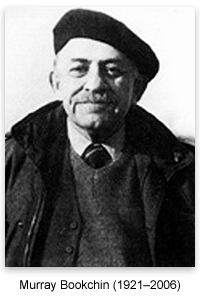
03/03/18
There are important similarities and differences between communalism and syndicalism. Syndicalism proposes the means of radical trade unionism towards the development of at least some kind of socialism (as in common ownership of the means of production). Communalism proposes the means and ends of federated community assemblies with embedded workers’ councils that directly democratically manage the political economy. Both theories and practices advocate for the means and ends of participatory democracy through organization and struggle. They both have different focuses for the prefiguration of that democracy–syndicalism focusing on a general union of workers and the workforce and communalism focusing on the community– and different ideal formal structures of social relations–syndicalism being rooted in radical unionism and often a vision of workers’ councils of some kind and communalism being rooted in communal assemblies as a means and ends.
In many ways syndicalism is to the workplace– production and distribution of goods and services– what communalism is to the community sphere. Syndicalism is an apolitical economic program in the sense that it often seeks to organize and reorganize society along economic lines via workers’ self management rather than on political lines through direct politics. Syndicalism organizes workers–and the reserve army of labor– towards economic action towards a new economic system. Communalism, unlike syndicalism, focuses on building a non statist political sphere– political meaning community and city management. Communalism organizes non-ruling class people throughout a larger community towards any kind of action in harmony with with minimal communalist principles and practices. Communalist principles and practices are rooted in direct democracy, non hierarchy, mutuality, co-federalism, ecology, communal self management, and communistic distribution etc. Communalist assemblies and radical trade unionism can both partake in 1. building directly democratic non hierarchical institutions 2. Mutual aid networks and meeting people’s needs 3. Periodic and sustained direct action and 4. Public education.
Unions can put their resources towards communalist assemblies as pointed out in Koloktronis’s brilliant essay on municipalist-syndicalism. Kolokotronis points out that unions have money, can help with finding meeting spaces, can help set up effective communication systems, can help with canvassing, and more. Kolokotronis calls on the importance of internal struggles within unions to become internally democratic as well as the importance of unions shifting towards a long term goal of community democracy. All of the above recommendations for a union/communalist synthesis are sound–even though there are many inhibiting factors. However, there are important ways that communalist organizing can benefit workplace organizing and unionism. Community assemblies can form and catalyze community solidarity networks. These solidarity networks can put pressure on any particular business from the outside. A combination between the internal pressure of workers flexing their labor power and community pressure external to workforces flexing people power–if done well in a coordinated way– can increase the overall effectiveness of any action against any capitalist power while strengthening regional anti capitalist action. Solidarity networks do not have the withheld labor power of strikes, but they decrease liability for many people to get involved in actions and can help add community power behind particular working class action–from strike support, to boycotts, to education campaigns, to capacity for various actions etc. Furthermore, this community assembly/solidarity network/union alliance gives community assemblies a class struggle character further cementing a class abolitionist ethos to community assemblies. Block by block, neighborhood by neighborhood, workplace by workplace, solidarity networks attached to community assemblies in tandem with unions can help build a network that fuels working class action and furthers communalist and syndicalist organizing as more and more people join the solidarity networks, connected communal assemblies, unions, alternative institutions, mutual aid projects, popular education events, and direct actions.
Capitalism organizes spatially and temporally and not just at the workplace. Community assemblies, and federations of community assemblies, can organize spatially and temporally to counter all ruling class action and to build horizontalist institutions. Solidarity networks and direct action collectives, as part of or connected to community assemblies, can give large scale community support for any particular direct action that happens throughout a city (or even region)– whether it is at the point of extraction, production, distribution, etc. Solidarity networks connected to community assemblies can help with everything from fights against landlord abuse, to fights against wage theft, to shutting down banks, to ecological direct actions, to adding support behind a union action, to opposing business as usual etc. They are an organization that can create a variety of content. Community assemblies and solidarity networks can also serve as a bridge between abstract ideals and abstract root problems and concrete ways to oppose hierarchy within a locality– a connection that goes back forth between generality and particularity and particularity and generality. Solidarity networks also bridge oppositional and reconstructive politics given that they usually use direct action towards mutual aid. Solidarity Networks can also potentially create tenants’ assemblies, block assemblies, and neighborhood assemblies through the process of organizing direct action campaigns.
Syndicalism and communalism are at odds with each other in some regards: mainly (but not only) due to disagreements about strategy and where primary organizing effort should be placed. Communalists want to develop communalist means towards communalist ends and see that as a keystone strategy to be developed. Whereas communalism does not essentially focus on organizing at the workplace–a great place to critique and expand upon communalist praxis– syndicalism sees workplace organizing and actions as the main way towards socialism. Despite communalism’s specificities in terms of being a horizontalist community assembly movement, communalism can organize oppositional and reconstructive politics at the points of reproduction of daily life, extraction, production, distribution, and community life. Gains for the working class and humanity more broadly have not just made through unions workplace actions and strikes but also thorough community assemblies, direct action collectives mutual aid collectives, affinity groups, specific issue social movement groups, etc. through things like occupations, expropriations, riots, sabotage, community self defense, marches, rallies, popular education, etc.
There are also common enough disagreements between syndicalists and communalists about what a conception of socialism should look like. Many syndicalists advocate for a mere workers’ self management model or a more complex council model which would place productive property in collective hands, but in a way that is still relatively private compared to a communal economy. Under communal property relations, the means of production needed for communes to reproduce themselves are directly in the hands of communes with workers’ councils embedded within the communal councils. The minimal practices and froms of communalism filter particular decisions affecting the commune through communal assemblies which are then implemented by participatory workers’ councils. Furthermore, communalism looks at needs and desires as the basis for production. Many syndicalists see syndicalism as a means towards needs based distribution (but not all). Some syndicalists even see syndicalism as what makes sense as the primary strategy towards a communalist society.
Under a communalist mode of production, community members collaborate in assemblies that discusses qualitative city management in particularities and as a whole–which includes but is not exhausted by quantitative economic matters. Embedded workers’ councils then self manage decisions within the policies and limits set by communal councils. The communalist mode of production is a political economy that integrates reproduction of daily life, production, consumption, distribution, economics, and politics into the horizontal commune. Mere council models of socialism advocate for the means of production to be divided among different groups within communities in such a way where the locus of policy for the economy is within particular workplaces rather than community assemblies.
The lower common denominators of communalism and syndicalism create a broad libertarian socialist alliance that has enough substance to meaningfully work in tandem on joint projects and actions. However, despite such agreements, there are also important incompatibilities between the two given that communalism is in favor of the communalization of economics and the prefiguration thereof via communal assemblies whereas syndicalism aims to develop some kind of socialism via radical unionism and workplace organizing.
Underlying libertarian socialism is an ethics of self management and freedom on every scale. Self management on every level requires communal self management. Communal self management requires communal ownership of means of production needed for communes to reproduce themselves. For communal assembly structures to be developed as ends, they also need to be developed as means. Therefore communalism is the logical extension of self-governance on every scale and mere socialism without communalism is a relative negation of such self-governance on every scale compared to communalism. The lack of communal self management under socialization of property without communalization of property is incompatible with communalism. However, syndicalist means can be put towards communalist ends, and communalist means can help syndicalist actions and joint projects to develop at least libertarian socialist conditions through libertarian socialist means. Such solidarity can happen without either losing their distinctions. However, communalism makes sense as a means AND an ends to be developed (and the major means towards communalist ends), whereas syndicalism makes sense as A means among many to be developed towards socialist and more specifically communalist ends.
///
Endnotes:
- Municipalist Syndicalism: Organizing the New Working Class by Alexander Kolokotronis (https://roarmag.org/essays/municipalist-syndicalism-alex-kolokotronis/)
- Anarcho Syndicalism: Theory and Practice by Rudolf Rocker (https://theanarchistlibrary.org/library/rudolf-rocker-anarchosyndicalism)
- The Communalist Project by Murray Bookchin (http://social-ecology.org/wp/2002/09/harbinger-vol-3-no-1-the-communalist-project/)


